The Museumsinsel (Museum Island) is a unique ensemble of museums on Spree Island in the centre of Berlin, the capital city of Germany. The island is surrounded by the Spree River. The museums on the Museumsinsel were built between 1824 and 1930. The museums were built to compete with cities like Florence, Paris and London. The Museumsinsel in Berlin illustrates the result of modern museum design in the 19th and 20th centuries. All together, the five museums on the Museumsinsel houses artefacts from more than 6,000 years old and numerous works of art. The Altes Museum houses a collection of Classical Antiquities. The most famous artefact of the Neues Museum is the bust of the Egyptian Queen Nefertiti. The Pergamonmuseum houses a collection of reconstructions of ancient architecture such as the Pergamon Altar, the Mshatta Façade, the Market Gate of Miletus, the Ishtar Gate of Babylon and the Aleppo Room. The Bode Museum houses Byzantine and Renaissance Art, among them works from Ravenna. The Alte Nationalgalerie houses work of French Impressionists. Nearly seventy percent of the museums were destroyed during WWII. The reconstruction and renovation of the museums took years and has given back the Museumsinsel its greatness. The Berliner Dom (Berlin Cathedral) was built in 1895-1905 and is the only building on the Museumsinsel, which is not a museum. The Berliner Dom was severely damaged during WWII, after restoration the Dom was reopened in 1992. Besides the Museumsinsel, there are another two UNESCO World Heritage Sites in Berlin: the Berlin Modernism Housing Estates and the Palaces and Parks of Potsdam and Berlin. Museumsinsel (Museum Island), Berlin gained the status as a UNESCO World Heritage in 1999. World Heritage Art: Nefertiti
www.werelderfgoedfotos.nl © Copyright World Heritage Photos Classic Car Road Trip
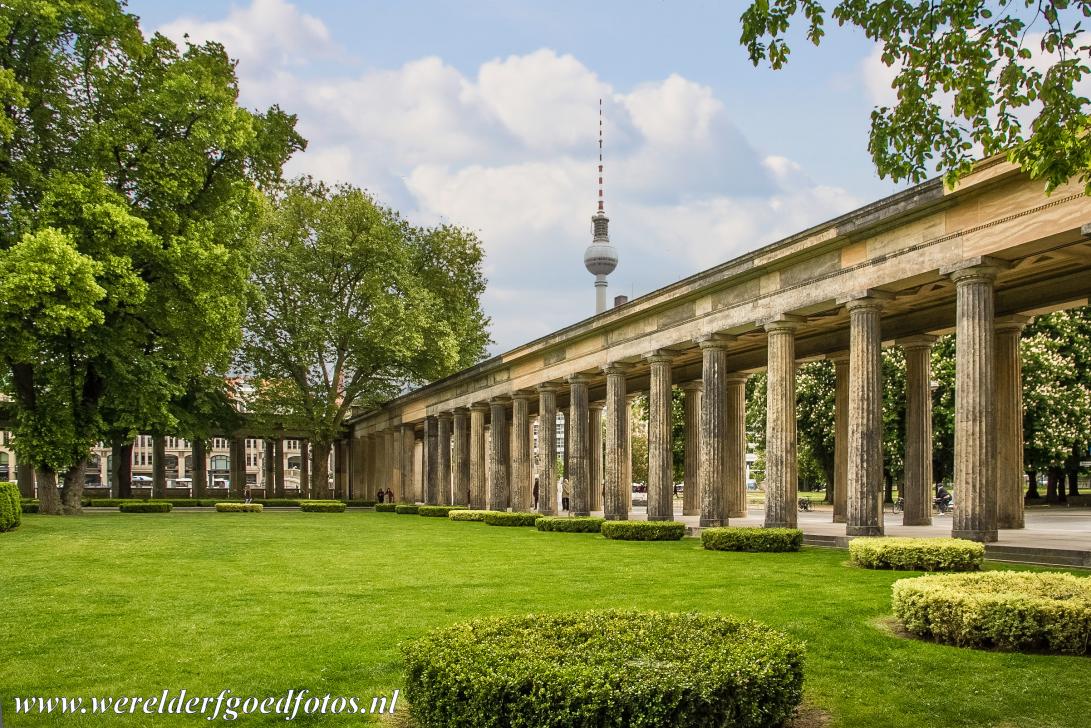
Museumsinsel (Museum Island): The Colonnade Courtyard near the Alte Nationalgalerie, in the background the TV tower, the Berliner Fernsehturm. The Museum Island is situated close to the centre of Berlin, the island is surrounded by the river Spree. The five museums on the Museum Island in Berlin illustrates the result of modern museum design in the 19th and 20th centuries. The Museumsinsel (Museum Island) in Berlin was declared a UNESCO World Heritage in 1999.

Museumsinsel (Museum Island): The Colonnade Courtyard near the Alte Nationalgalerie, in the background the TV tower, the Berliner Fernsehturm. The Museum Island is situated close to the centre of Berlin, the island is surrounded by the river Spree. The five museums on the Museum Island in Berlin illustrates the result of modern museum design in the 19th and 20th centuries. The Museumsinsel (Museum Island) in Berlin was declared a UNESCO World Heritage in 1999.
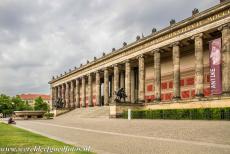
Museumsinsel, Museum Island Berlin: The Altes Museum, German for Old Museum, was Berlin's first museum, it was built in the Neoclassical style from 1823 to 1830. The museum was totally destroyed during WWII and reconstructed between 1950 and 1966. The Altes Museum houses an imposing collection of Classical Antiquities, among them the Hildesheim Treasure, the largest collection of Roman silver (first century BC) found outside the frontiers of the Roman Empire.
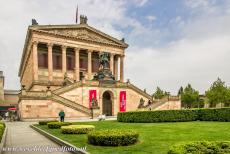
Museumsinsel (Museum Island), Berlin: The Alte Nationalgalerie was opened in 1876 in the presence of the German Kaiser. The Alte Nationalgalerie was heavily damaged during WWII. The museum was partially reopened in 1949. The restoration of the Alte Nationalgalerie took many years, it was finally reopened in 2001, marking its 125 anniversary. The collection includes works of art from French Impressionists such as Edouard Manet and Paul Cézanne.
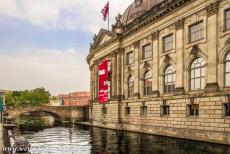
Museumsinsel (Museum Island): The Bode Museum was designed by Ernst von Ihne and built in 1897-1904. The Neo-Baroque museum was heavily damaged during WWII, it underwent several stages of restoration between 1948 and 2006. After the renovations, the museum was reopened in 2006, the Bode Museum houses Byzantine and Renaissance art, and a collection of coins and medals. The Bode museum is situated at the northwestern tip of the Museumsinsel in Berlin.
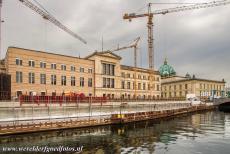
Museumsinsel (Museum Island), Berlin: The Neues Museum was built between 1843 and 1855. The museum was heavily damaged and partly destroyed during WWII. It was reconstructed in the period 1999-2009. The three main wings of the museum surround two interior courtyards. The major artefact of the Neues Museum is the limestone bust of the Egyptian Queen Nefertiti. Museumsinsel (Museum Island) in Berlin was declared a UNESCO World Heritage in 1999.
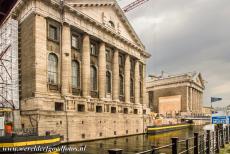
Museumsinsel (Museum Island), Berlin: The Pergamonmuseum was built from 1910 to 1930. The Pergamonmuseum was damaged during WWII and reconstructed in the period 2005-2010. The huge museum houses Ancient Near Eastern Art, Islamic Art and original-sized reconstructed ancient architecture such as the Pergamon Altar, the Aleppo Room, the Market Gate of Miletus, the Mshatta Façade and the Ishtar Gate, one of the eight gates of the inner city of Babylon.
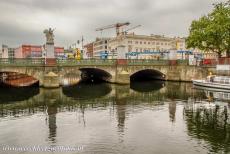
Museumsinsel (Museum Island), Berlin: The Schlossbrücke is a stone arch bridge over the river Spree. The bridge was built in the beginning of the 19th century. The Museumsinsel is an island in the central Mitte district of Berlin. The island is surrounded by the Spree River and reachable by bridges. The Museumsinsel is a unique complex of museums in the centre of Berlin, it is one of the most visited tourist attractions in the city.
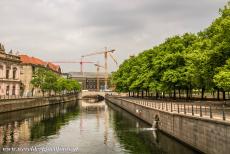
Museumsinsel (Museum Island), Berlin: The river Spree. On the right hand side the Lustgarten, the Pleasure Garden, on the Museumsinsel. In the background the huge tower cranes near the Pergamonmuseum, the renovation of the Pergamonmuseum was completed in 2019, but parts of the museum are still closed to visitors. The Lustgarten is situated in front of the Berliner Dom, the Berlin Cathedral, and the Altes Museum. The Lustgarten is a popular city park in Berlin.
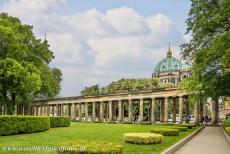
Museumsinsel (Museum Island): The Colonnade Courtyard near the Alte Nationalgalerie, in the background the green copper dome of Berlin Cathedral, the Berliner Dom. The Berliner Dom is the only building on the Museumsinsel in Berlin, which is not a museum. The Hohenzollerngruft, the Royal Crypt below the Berliner Dom, is the final resting place of a large number of Prussian Kings and members of the House of Hohenzollern, the former imperial dynasty of Germany.
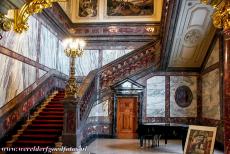
Museumsinsel (Museum Island), Berlin: The Imperial Staircase of the Berliner Dom, the Berlin Cathedral. Until the end of the monarchy in 1918, the German Emperor Wilhelm II and his wife Empress Augusta Victoria would enter the Berliner Dom via this staircase. The Berliner Dom was built from 1895 to 1905. The Dom was severely damaged during WWII. After years of restoration the Dom was reopened in 1992. The Royal Crypt underneath the cathedral is open to visitors.
